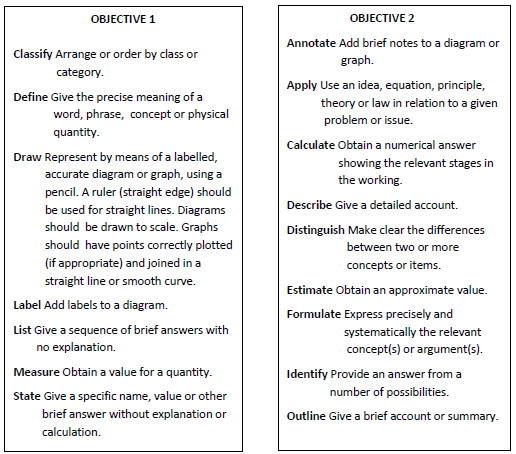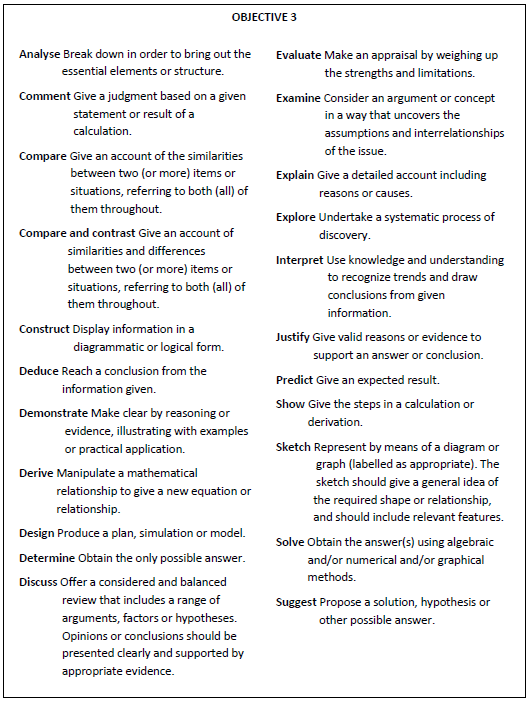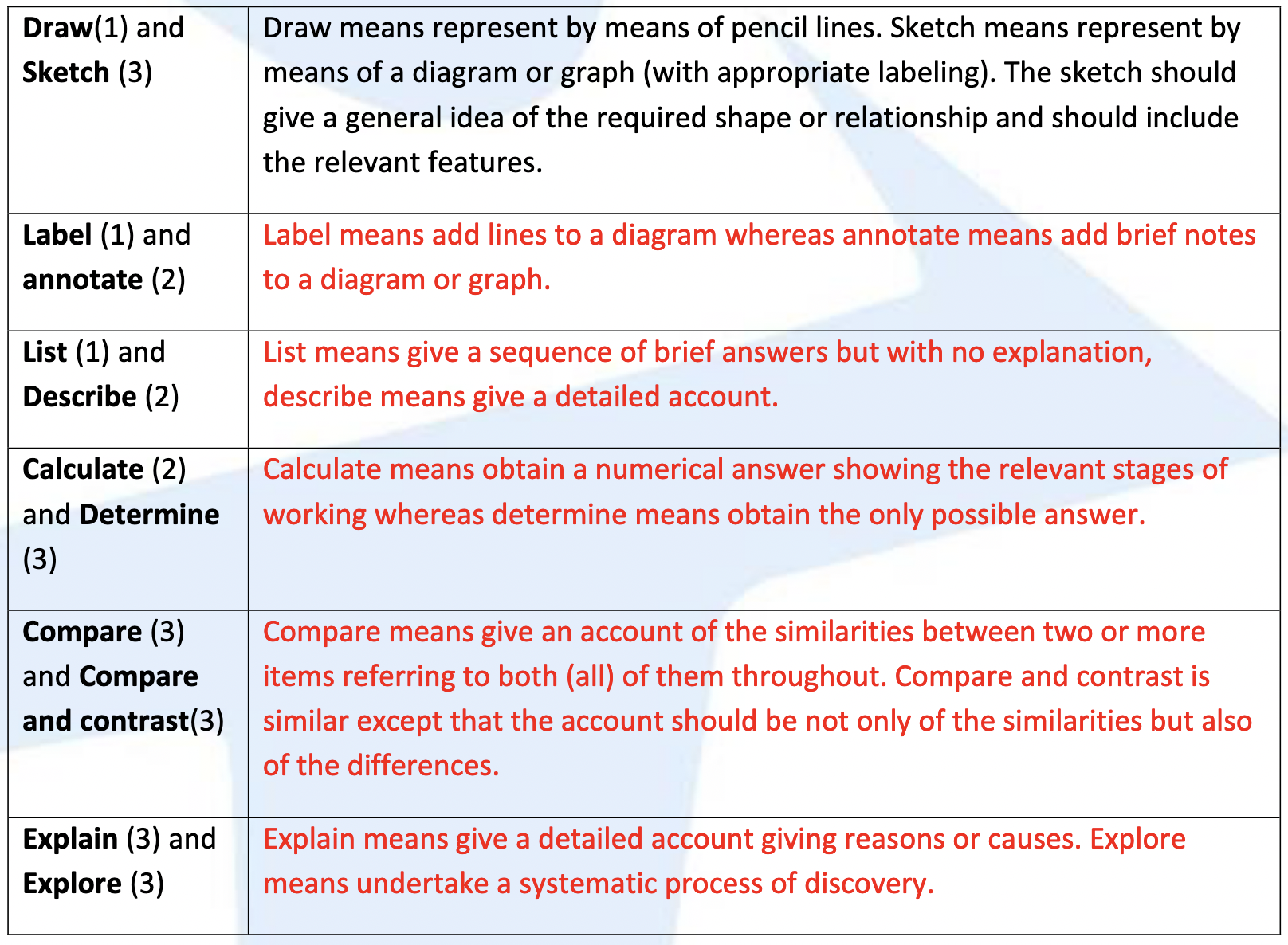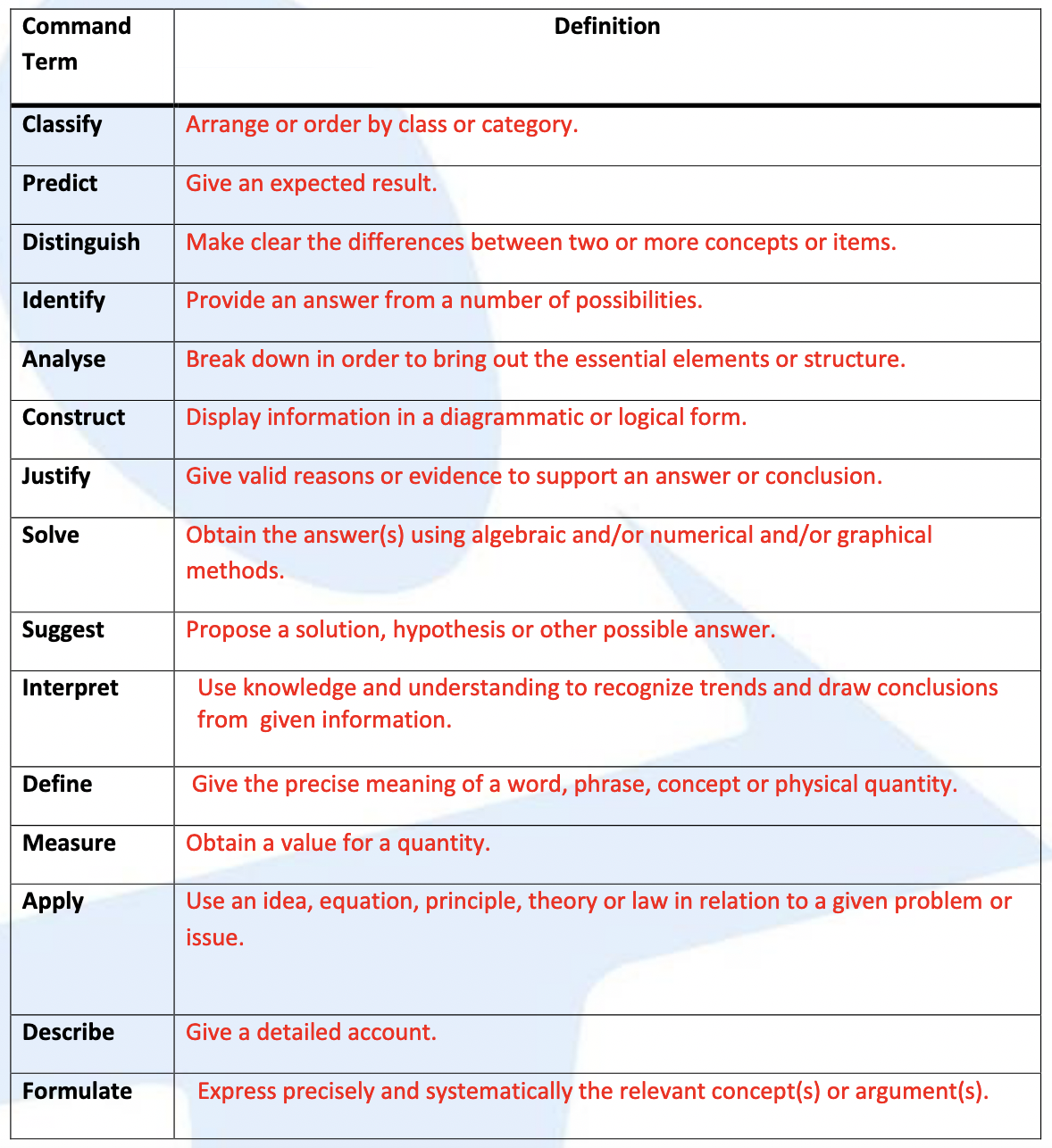Objectives & command terms
Objectives
The objectives reflect the aims in the syllabus that will be assessed.
The IB lists four specific objectives.
The first three objectives are:
1. Demonstrate knowledge and understanding of:
a. facts, concepts, and terminology
b. methodologies and techniques
c. communicating scientific information.
2. Apply:
a. facts, concepts, and terminology
b. methodologies and techniques
c. methods of communicating scientific information.
3. Formulate, analyse and evaluate:
a. hypotheses, research questions and predictions
b. methodologies and techniques
c. primary and secondary data
d. scientific explanations.
These three objectives are tested on the three written papers.
The fourth objective, Objective 4, states:
"Demonstrate the appropriate research, experimental, and personal skills necessary to carry out insightful and ethical investigations."
This is related to the internal assessment and is essentially tested through the internal assessment although some of the skills learned through practical work will also be tested in Section A of Paper 3.
In plain English, Objective 1 means state a definition or fact, Objective 2 means apply this knowledge in a straightforward situation and Objective 3 means that you have to determine how to solve a problem by selecting the relevant information or method yourself.
For example, define pH (Objective 1), calculate the pH of 1.50 x 10-2 mol dm-3 hydrochloric acid (Objective 2) and determine the mass of ammonium chloride that must be dissolved in 1.00 dm3 of 1.00 x 10-1 mol dm-3 ammonia solution to produce a buffer solution with a pH of 9.00 (Objective 3).
Command terms
Command terms were introduced into the IB some years ago (they used to be called ‘action verbs’). They are in fact imperative forms of verbs. In previous syllabi they were used to indicate, both in the guide and in the examinations, the depth of treatment required for a given assessment statement. In the current syllabus they are only used in the examinations and are not found in the detailed syllabus for each sub-topic. Because they are used in every question (actually command!) in Papers 2 and 3 it is important that you are completely familiar with their definition. All three papers consist of questions testing approximately 50% Objectives 1 and 2 and 50% Objective 3, although this is not so obvious in Paper 1 as the command terms are not used. A list of all the command terms used in chemistry together with their definitions is given below. Note that some of them have a very precise meaning which may not be how they are always used in other contexts. One obvious one is the word ‘outline’. In some other non-IB examinations outline the mechanism can mean give a very detailed account using curly arrows to show the separate steps in an organic reaction mechanism. In the IB outline means give a brief account or summary. Note that the current programme lists some command terms that have not appeared on previous programmes. These are Classify, Formulate, Compare and contrast, Demonstrate, Examine, Explore, Interpret and Justify. It is also worth noting that at the beginning of the glossary it says, "Although these terms will be used frequently in examination questions, other terms may be used to direct students to present an argument in a specific way".
Some teachers paste a list of all the command terms and their definitions up on the wall in the classroom or laboratory. This can be particularly useful if English is not your first language. However if you are also studying Physics or Biology be aware that the command terms used are not exactly the same for the three subjects. The chemistry command terms are:


One of the main reasons why you might lose marks on Papers 2 and 3 is that you have not answered the actual question asked because you failed to understand or address the command term used. For example "Describe what you will see when you add hydrochloric acid to calcium carbonate" will require a very different answer to "Explain what happens when you add hydrochloric acid to calcium carbonate".
You can test understanding of command terms by doing the following quiz where you need to match up the correct command term with the description given.
1. Obtain a numerical answer showing the relevant stages in the working.
2. Make clear by reasoning or evidence, illustrating with examples or practical
application.
3. Break down in order to bring out the essential elements or structure.
4. Make clear the differences between two or more concepts or items.
5. Obtain the only possible answer.
6 Undertake a systematic process of discovery.
7. Give an account of similarities and differences between two (or more) items or
situations, referring to both (all) of them throughout.
8. Give valid reasons or evidence to support an answer or conclusion.
9. Express precisely and systematically the relevant concept(s) or argument(s).
10. Give an expected result.
To help you further you might like to try the following three exercises.
The first exercise is a nice 'simple' test in which you need to match up the command terms with their meanings and with their objective level. It was devised by Chris Hamper who is the author of the InThinking Physics website.
Be warned that the second exercise (below) is not as easy as it looks! I obtained this exercise from a participant at a workshop I ran - I do not know who first put it together but I am very grateful to them. I'm also grateful to BIB Docs (2) Teammathy Gopalakrishnan, a chemistry workshop leader from Bangalore, who updated the exercise for the new programme.
Test your knowledge of command terms
Distinguish (give the differences between two or more different items) between:


 IB Docs (2) Team
IB Docs (2) Team 



